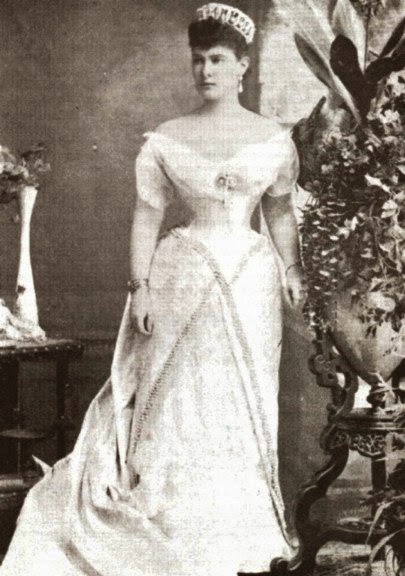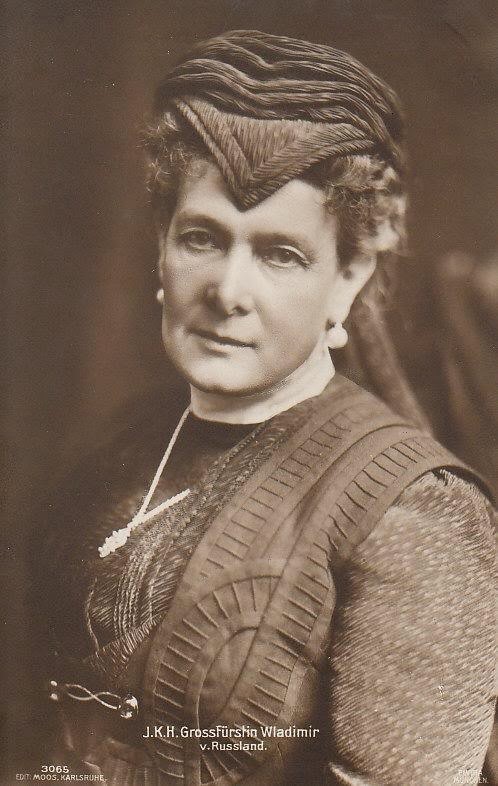 |
| (source) |
1874: In August, twenty-year-old Marie of Mecklenburg-Schwerin becomes a member of the Romanov dynasty when she marries Grand Duke Vladimir Alexandrovich of Russia. Vladimir is the third son of Tsar Alexander II of Russia; Marie is the elder daughter of Grand Duke Friedrich Franz II of Mecklenburg-Schwerin. Marie also has Romanov heritage of her own: she’s the great-granddaughter of Grand Duchess Elena Pavlovna of Russia. To honor her Russian great-grandmother, Marie adopts the name “Maria Pavlovna” after her wedding in St. Petersburg. Her family calls her “Miechen.”
 |
| (source) |
Formal dress at the imperial court is elaborate, and Grand Duchess Maria Pavlovna needs a new tiara to wear. The Romanov court jeweler, Bolin, makes her a tiara of interlocking diamond circles, set in gold and silver, with pear-shaped pearl drops. The piece becomes known as the “Vladimir Tiara.” Miechen’s jewel collection grows quickly, as does her extravagant court circle, and she becomes a rival to the other Romanov women.
 |
| (source) |
ca. 1880: Maria Pavlovna wears the tiara in a closed circlet form, without the backing row of curved diamonds and the pearl drops (or “widowed”). Based on her costume, she is presumably attending one of the famous Romanov historical masquerade balls; the costume she wears echoes seventeenth-century fashion.
 |
| (source) |
1891: An illustration of Maria Pavlovna wearing the tiara appears on the cover of Le Petit Journal.
 |
| (source) |
1902: Vladimir and Maria Pavlovna’s only daughter, Grand Duchess Elena Vladimirovna, marries Prince Nicholas of Greece and Denmark. (She will become the mother of three Greek princesses, including Marina, who will later marry the Duke of Kent.) At some point before her marriage, Elena poses with her mother in full imperial court dress. In the portrait, Maria Pavlovna wears the Vladimir Tiara.
 |
| (source) |
1904: Maria Pavlovna sits for a portrait wearing the tiara and full Russian imperial court dress.
 |
| (source) |
1909: Maria Pavlovna becomes a widow when her husband, Grand Duke Vladimir, dies of a stroke.
 |
| (source) |
1917: Following the February Revolution, Tsar Nicholas II abdicates. Maria Pavlovna is advised to flee St. Petersburg. She leaves the palatial Vladimir Palace for a villa in Kislovodsk; her jewels, including the tiara, remain in a hidden safe in her bedroom at the palace. When the government becomes suspicious of her correspondence, she is placed under house arrest, and her financial situation becomes increasingly precarious.
That summer, Maria Pavlovna’s son, Grand Duke Boris (pictured above), and a friend, Bertie Stopford, hatch a dangerous plan to retrieve her jewels. Stopford is an aristocratic British art dealer who also has diplomatic ties. He and Boris disguise themselves as workmen, and with the help of a palace caretaker, they sneak into the Vladimir Palace and smuggle out the contents of Miechen’s secret safe. The Vladimir Tiara and her other jewels are placed in a pair of Gladstone bags, and Stopford manages to sneak them out of Russia. He takes the jewels to London, where they are placed in a safety deposit box.
1920: In January in London, Garrard creates an inventory of Maria Pavlovna’s jewels. The list shows that the Vladimir Tiara was damaged during its journey from Russia to England; some of the pearls and diamonds are missing from the piece.
 |
| (source) |
In February, Maria Pavlovna is the last Romanov grand duchess to escape from Russia. She boards an Italian steamer that takes her to Venice; from there, she travels to France. The journey takes a serious toll on her health. In her villa in the small town of Contrexéville, she dies in September at the age of sixty-six.
1921: Grand Duchess Elena, now Princess Nicholas of Greece and Denmark (pictured above), decides to sell some of her mother’s jewels, including the Vladimir Tiara. Queen Mary of the United Kingdom steps in and purchases several pieces. Among her acqusitions is the Vladimir Tiara, which she sends to Garrard for much-needed repairs.
1924: Mary decides to make the Vladimir Tiara more adaptable. Garrard adjusts the tiara so that it can be worn with the original pearl drops or with a set of fifteen emerald drops. These stones are a part of the collection of Cambridge emeralds, which were won by Mary’s grandmother, the Duchess of Cambridge, in a charity lottery. The emeralds had originally been inherited by Mary’s brother, who left them to his mistress; however, Mary had managed to reacquire them — though the details of that particular transaction are a bit hazy.
ca. 1930: Mary wears the pearl version of the tiara.
1935: Mary wears the pearl version of the tiara in the official portrait taken for her husband’s Silver Jubilee.
1936: An image of Mary wearing the pearl version of the tiara is included in the souvenir book printed for Edward VIII’s coronation — an event which, because of his abdication, never happens.
1953: Queen Mary dies, and the tiara is inherited by her granddaughter, Queen Elizabeth II.
1954: Elizabeth wears the tiara to the Royal Film Performance of Beau Brummel.
1961: Elizabeth wears the tiara with the Cambridge emerald drops; she pairs it with jewels from the Delhi Durbar parure.
1966: Elizabeth wears the tiara with pearls at the Austrian embassy in London.
1969: Elizabeth wears the tiara during a state visit to Austria.
1976: Elizabeth wears the tiara during a trip to the United States.
1978: Elizabeth wears the tiara during an official tour of Germany.
1980: The tiara is paired with a black veil during a visit to the Vatican.
1983: Elizabeth wears the tiara during a visit to San Francisco.
1986: Elizabeth wears the pearl version of the tiara in Nepal.
1988: Garrard does a complete refurbishment of the tiara, which by now is more than a century old. The frame of the piece is entirely rebuilt.
1994: The Cambridge emerald drops are worn with the tiara during a state visit from Zimbabwe.
1999: Elizabeth wears the tiara with pearls during the Chinese state banquet.
2004: Elizabeth wears the tiara again with pearls for a state banquet.
2006: In a rare appearance, Elizabeth wears the tiara “widowed” (without drops) during a tour of the Baltic States.
2014: Elizabeth uses the emerald drops to honor the Irish president during a state banquet.
Leave a Reply